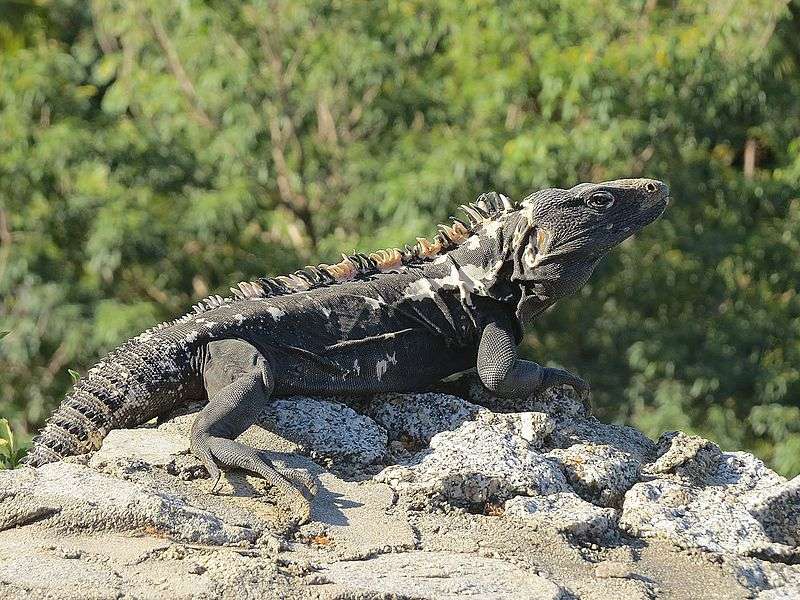
Description:
Scientific name: Ctenosaura pectinata
Life span: 15 years
A species of moderately sized lizard belonging to the Iguanidae family is called Ctenosaura pectinata. Typically, the dorsal color is brown or gray-brown, and the ventral surface is yellowish. Its back is covered in a crest of long spines that runs straight down the middle. Hatchlings often have no body pattern and a brilliant green color, which darkens with age.
In the head or dorsal regions, Ctenosaura pectinata frequently (but not always) displays an uneven piebald pattern. C. pectinata often lacks a visible or well developed crossband pattern on the body, which is frequently present in the similarly looking and closely related species Ctenosaura similis and Ctenosaura acanthura. However, the tail may be banded with light and dark crossbands. Pectinata Ctenosaura. Except for the black tail bands that are visible on adults, the young are bright green and unmarked.
Native Region/Habitat
It can be found in Mexico from southern Chiapas to central Sinaloa. Moreover, Florida and the southernmost point of Texas are where it was first brought to the United States.

Behavior:
Unlike other Ctenosaura species, which tend to be solitary creatures, C. pectinata is a sociable lizard that has adapted to living in groups. These iguanas are skilled climbers and favour rocky habitats with lots of hiding places, boulders for sunbathing, and surrounding trees to scale. They are nocturnal and swift, using their speed to elude predators, but if caught, they will lash out with their tails and bite. In their native Mexico and in places where they have been imported elsewhere, they are frequently seen living close to or around towns.
The main food source for young people is insects. Adults, on the other hand, eat a variety of flowers, leaves, stems, and fruit. They also occasionally eat tiny animals, eggs, and arthropods depending on the situation.
Care As a pet/In captivity:
The terrarium: Depending on the size of the iguana you have, different terrarium conditions are needed for Western spiny-tailed iguanas. The smallest enclosures that should be used for a single Western spiny-tailed iguana or a pair are listed below:
Smaller Western spiny-tailed iguanas, less than 45 full length cm: 60 cm in width, 90 cm long, and 60 cm high. Bigger species, measuring 180 cm long by 60 cm wide and 80 cm high.
Lighting and temperature: Iguana with a spiky tail found in Western He’s a saurian who loves the sun. For them, outside enclosures work best. Indoor cages must contain two or more full-spectrum bulbs running the length of the enclosure and a sun light bulb (perhaps two, depending on the size of the cage) at one end. Sun shelves or other locations should be placed no farther than 25 cm from the lamp in order to maximize the benefits of full spectrum lighting. The enclosure should have an average temperature of 25 to 30 °C, with sunny areas reaching 35 to 40 °C.
Substrate and accessories: The cypress substrate is usable. You can also use rabbit pellets, but you don’t have to nebulize them. Give your Western spiny-tailed iguana lots of branches and/or cork boards so it can climb. Also, there should be numerous hiding spots, such as appropriate-sized cork bark holes. Live edible plants should be used, such as hibiscus, whose leaves and blooms can be consumed. Because many systemic insecticides and fertilizers can be active in plants and soil for at least 30 days, it is advisable to purchase plants at least 30 days before you intend to utilize them.
Food: Adult Western spiny-tailed iguanas are fed a variety of meals, including grated carrots, mulberry and hibiscus leaves, mixed greens, and edible wild plants including dandelions, purslane, and clover. There may also be seasonal fruits and vegetables available. Feed Western spiny-tailed iguana hatchlings and young the same diet as adults, but you can also give them some insects, primarily crickets that are half as big as the young lizards’ heads. Zoophobas, tomato hornworms, and silkworms can all receive them. Two or three times a week should be provided as calcium and vitamin supplements (pregnant females should receive calcium supplements daily). Dry commercial diets are also available for iguanas.
Since the Western spiny-tailed iguana pups will sip the plant’s water droplets, water misting is the preferred form of irrigation. A water dish can also be placed inside the enclosure, but make sure it is substantial enough to stay put. Your iguana’s attention can be attracted to the water dish by misting it. Do not vaporize if you use rabbit pellets as a substrate.
Table





